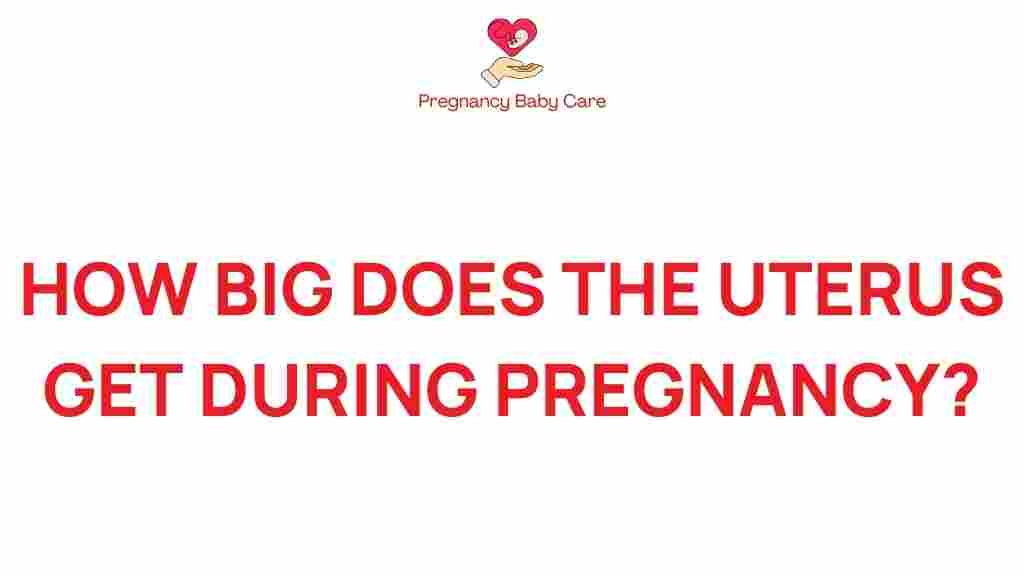The Remarkable Expansion: How Big Does the Uterus Get During Pregnancy?
Pregnancy is a miraculous journey, marked by numerous physical and emotional changes. One of the most significant transformations occurs in the uterus, a vital organ that undergoes remarkable expansion to accommodate the growing fetus. Understanding the changes in the uterus size during pregnancy is crucial for expecting mothers. This article will explore the stages of pregnancy, the changes in the uterus, and the implications for maternal health.
Understanding the Uterus and Its Function
The uterus, also known as the womb, is a muscular organ located in the female pelvis. Its primary function is to house and nourish the developing fetus throughout the gestation period. During pregnancy, the uterus undergoes significant changes in size and shape to support fetal development.
The Anatomy of the Uterus
The uterus is divided into several parts:
- Fundus: The top portion of the uterus, which expands significantly during pregnancy.
- Body: The main part of the uterus where the fetus develops.
- Cervix: The lower part that opens into the vagina, which remains tightly closed during pregnancy to protect the fetus.
Pregnancy Changes: Stages of Uterus Expansion
Throughout the pregnancy stages, the uterus size changes dramatically. Here’s a breakdown of how the uterus transforms during each trimester.
First Trimester (Weeks 1-12)
In the early weeks of pregnancy, the uterus is about the size of a pear. By the end of the first trimester, it expands to the size of a grapefruit. This growth is primarily due to hormonal changes and increased blood flow. Key changes include:
- Thickening of the uterine lining.
- Increased vascularization to support fetal development.
- Initial stretching as the embryo begins to grow.
Second Trimester (Weeks 13-26)
During the second trimester, the uterus continues to grow rapidly. By week 20, it may reach the height of the belly button. Changes during this stage include:
- Significant expansion in both length and volume.
- Increased abdominal size as the uterus pushes against surrounding organs.
- Enhanced fetal movement as the baby becomes more active.
Third Trimester (Weeks 27-40)
In the third trimester, the uterus reaches its maximum size, resembling a large watermelon. By the end of this stage, the uterus can weigh up to 2.5 pounds. Notable changes include:
- Full accommodation of the growing fetus.
- Pressure on the bladder, leading to increased urination.
- Stretching of the abdominal muscles and skin, which may result in stretch marks.
Fetal Development and Uterus Size
The growth of the uterus is directly related to fetal development. As the baby grows, the uterus expands to provide necessary space and nutrients. Here’s how fetal development correlates with changes in uterine size:
Weeks 1-12: Early Development
During the first trimester, the embryo develops crucial organs and systems. The rapid increase in uterus size supports this foundational growth.
Weeks 13-26: Growth and Movement
In the second trimester, the fetus begins to grow extensively, developing more defined features. The expanding uterus allows for increased movement, which is often felt by the mother.
Weeks 27-40: Preparing for Birth
In the final trimester, the fetus continues to grow, often reaching a weight of 5-10 pounds. The uterus adjusts to accommodate this growth, preparing for the process of childbirth. Changes in the uterus and maternal body include:
- Preparation for labor through Braxton Hicks contractions.
- Positioning of the fetus for delivery.
- Heightened awareness of physical discomfort due to size and pressure.
Maternal Health and Uterus Size
As the uterus expands, it is crucial for mothers to monitor their health. Significant growth can lead to various physical changes and potential health issues. Some important considerations include:
Physical Discomfort
As the uterus grows, expectant mothers may experience:
- Back pain due to altered posture.
- Pelvic pressure as the fetus moves downwards.
- Shortness of breath if the uterus compresses the diaphragm.
Emotional Well-being
The changes in the body can also impact mental health. It’s essential to maintain a support system and engage in activities that promote emotional well-being.
Monitoring Health During Gestation
Regular prenatal care is essential for ensuring both maternal and fetal health. This includes:
- Regular check-ups with a healthcare provider.
- Monitoring weight gain and nutritional needs.
- Staying informed about potential complications.
Childbirth: The Final Transformation
As the pregnancy nears its end, the uterus prepares for childbirth, a remarkable process that showcases its strength and adaptability. Understanding how the uterus transitions during this phase is critical for expectant mothers.
Labor and Delivery
During labor, the uterus contracts to help push the baby out. Key points include:
- Contractions help dilate the cervix.
- Powerful muscle contractions assist in moving the baby through the birth canal.
- Post-delivery, the uterus shrinks back to its pre-pregnancy size, a process known as involution.
Postpartum Recovery
After childbirth, the body undergoes further changes, and recovery is essential for maternal health. Considerations include:
- Rest and nutrition to aid in recovery.
- Monitoring for any signs of complications.
- Emotional support during the adjustment to motherhood.
Conclusion
The expansion of the uterus during pregnancy is an extraordinary process that highlights the body’s ability to adapt and nurture new life. From the early weeks of gestation to the final stages of childbirth, the uterus size changes significantly, reflecting the growth of the fetus and the evolving needs of the mother. Understanding these changes can empower expectant mothers to maintain their health and well-being throughout this transformative journey.
For more information on pregnancy and maternal health, consult resources like the American Pregnancy Association or speak with your healthcare provider. Remember, every pregnancy is unique, and staying informed is key to a healthy experience.
As you embark on this journey, embrace the changes and the incredible experience of bringing new life into the world.
This article is in the category Pregnancy and created by PregnancyBabyCare Team
